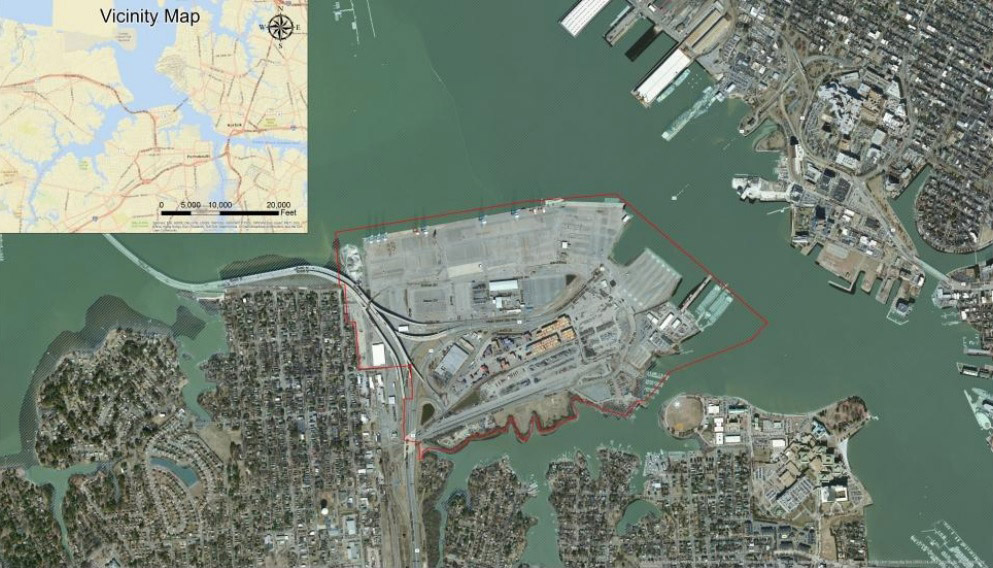
The Port of Virginia has agreed to lease 72 acres of its Portsmouth Marine Terminal to Dominion Energy (NYSE: D) for 10 years to support development of the 2.6-GW Coastal Virginia Offshore Wind (CVOW) project.
“Dominion will use the deep water, multi-use marine cargo terminal as a staging and pre-assembly area for the foundations and turbines to be constructed about 30 miles off the coast of Virginia Beach,” Gov. Ralph Northam said Wednesday in his welcome address at the Business Network for Offshore Wind’s International Partnering Forum (IPF).
Northam counted the agreement as the latest in a series of “concrete actions” the state is taking to grow its offshore wind industry.
A 2015 report from the Virginia Department of Mines, Minerals and Energy identified the state-owned port as capable of accommodating multiple OSW activities. Negotiations on Dominion’s lease accelerated in July, when the Virginia Port Authority Board of Commissioners directed the authority to finalize the agreement, according to the governor’s office.
The lease, which is valued at $4.4 million annually, has an option for two five-year renewals, the governor’s office said. The agreement also includes significant upgrades to ensure the terminal can handle the weight of turbine components.
Ørsted reached an agreement last year with the Port of Virginia for an initial 1.7-acre lease at the Portsmouth Marine Terminal through 2026, with an option to expand to an additional 40 acres.

The facilities comprising the Port of Virginia, which include four other marine terminals, generate $92 billion in total economic impact throughout Virginia on an annual basis, according to Northam. The state, he said, is “doing more with additional projects planned or underway to increase water and rail access, further enhancing the port’s competitiveness and value.”
Given the state’s proximity to the major East Coast OSW development areas, which are less than a day’s sail away, he said, Virginia is “the perfect hub for this booming industry.”
Since the signing of an offshore wind memorandum of understanding last October among Virginia, North Carolina and Maryland, the states have heard from stakeholders on how the partnership can help expand OSW.
“We will look at ways to enhance our state permitting process and create cross-state workforce development initiatives,” Northam said, adding that the states also will collaborate on ways that companies can work with state permitting agencies.
The Bureau of Ocean Energy Management in July announced its intention to review the CVOW project and prepare an environmental impact statement, which isn’t due until 2023 under current permitting timeframes. (See BOEM Beginning Environmental Review on Va. OSW Project.)
Industry First
Development of the 132-MW South Fork offshore wind farm has delivered a first for the U.S. and the industry with a deal for construction of the project’s substation in Texas.
Together with project partner Eversource, Ørsted awarded the offshore substation contract to Kiewit Offshore Services.
“More than 350 workers across three states will support this project with engineering, procurement and project management scopes for approximately 18 months,” CEO of Ørsted Offshore North America David Hardy said during the IPF opening plenary session.
The contract represents a crossover of skills from the oil and gas industry to offshore wind, Liz Burdock, CEO of the Business Network for Offshore Wind, said in a statement.
“The complexity and size of this major component essential to an offshore wind project will also require vendors from all over the country to supply products and services,” she said.
Kiewit will build the 1,500-ton, 60-foot-tall substation at its facility near Corpus Christi, Texas, with support from teams in Houston and Kansas, according to a statement from the companies.
“After it’s built, it will be sailed up to New York where union workers will help with the final installation and commissioning, as well as perform many other scopes for offshore and onshore parameters of the project,” Hardy said.
Kiewit expects to begin construction on the substation in November.

